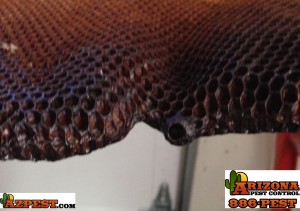The worker bees are sexually underdeveloped females smaller than the queen but capable of laying small numbers of eggs under some conditions. Worker bees that lay eggs are called laying workers. Their eggs, usually placed in worker cells, develop into undersized but functional drones.
Worker-bee larvae hatch from the eggs in 3 days, are fed royal jelly for 2 1/2 days, and then their diet is changed to include pollen and honey for 2 1/2 days. They are sealed in their cells for 12 days, during which period they spin a cocoon and transform from the larvae to the pupae, emerging as adult bees 20 days after the eggs were laid.
The difference in the cell and food environment causes the worker bees to require 5 days longer to develop than the queen, yet their life expectancy is only 5 weeks during the summer and a few months during the winter. Any worker larva under 24 to 48 hours old can be developed into a queen under the proper colony conditions that insures the nurse bees will construct a queen cell and feed royal jelly lavishly to the developing larva. The rearing of queens for market is a highly specialized field of beekeeping.
The worker bees differ markedly from the queen in many respects other than function, length of life, and behavior. Structurally they have a longer tongue for gathering nectar, modified mandibles (jaws) especially designed for comb building, special glands for secreting royal jelly, enzymes for the conversion of nectar into honey, and glands that function in communication; highly specialized leg structures for gathering and carrying pollen, four pairs of wax glands on the underside of their abdomen for the secretion of wax, and a straight barbed sting for the defense of the colony. The queen’s sting is curved and smooth and is used only to destroy rival queens.
Text Information via U of A, we are simply sharing the photo as an example and referring this so you know what we are showing you.












